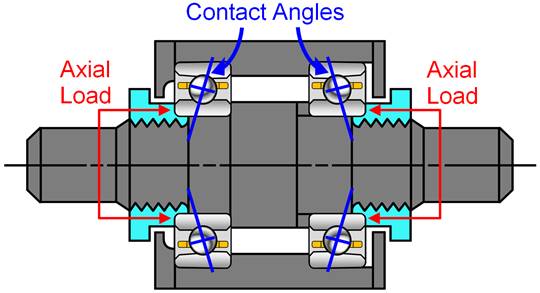
Bearing preload is critical in encoder spindle designs. Preload is the application of an axial load across a pair of bearings that removes the free internal clearance (or looseness) that is present in each bearing by design.
In an encoder application, this preload forces the balls into contact with the raceways allowing for load sharing and precise rotational movement. In addition, as preload is increased, the encoder spindle assembly stiffness increases. This prevents ball skidding under acceleration (and deceleration) and improves repeatability and stability.
Higher values of preload, however, also have some undesirable effects. These include increased friction, heat, stress in the raceways and ultimately bearing life is reduced. The designer must balance the need for higher preload values with these negative consequences.
The fits – both shaft and housing – for the smaller bearings used in an encoders are typically light transitional fits to clearance fits. It is very common to use adhesives to secure the bearings in place. This also allows for the use of the dead weight preload method where, during the assembly process, a weight is applied to the encoder spindle (in the vertical position) while the adhesive applied to the bearings cures.
After cure, the weight is removed. This is very easy to control and produces very consistent results. Interference fits can be problematic in bearings with thinner cross sections. Poor geometry in the mating components is easily transferred to the higher precision bearings, and, if combined with components that are at their maximum limits of size, the bearing clearance can be reduced to negative values resulting in high stress and heat in operation.
For part IV, environmental specifications, click here
Need assistance or further information on bearing choices for encoders, or any other application? Our bearing experts and engineers are ready to help, contact them here.

